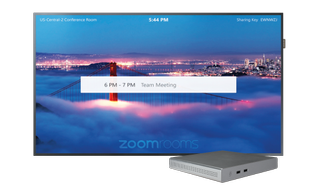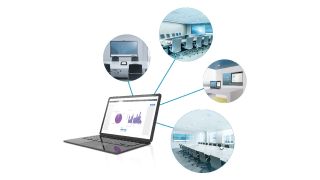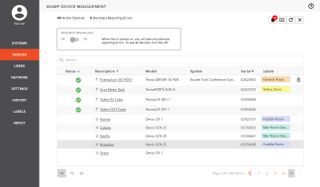
More AV devices are ported for IP. More feeds are migrating to the enterprise network. More AV systems are software-driven. Convergence is a done deal, right? Not quite. There are still growing pains when it comes to deploying AV at scale. While audiovisual technologies are still the “magic”—from mesmerizing 4K to immersive audio—applying IT acumen in the planning stage will help build efficiencies, no matter where you are in the AV/IT conversation.
WHAT DO IT MANAGERS WANT?
All content, all access, all of the time—this is the mantra of Millennials, the dominant contingent of today’s workforce. Gen Z, born approximately between 1995 and 2005, will demand even more bandwidth and the latest tech tools at work. Expect more video-driven communications to support the pervasive meeting culture. Video and connectivity need to be “everywhere,” even outside, explained Tim Maffei, senior director of IT at EVERFI, a fast-growing edtech software company. “That’s where relying on a traditional conference phone, a big TV, or projector won’t cut it.”
According to a study from Gartner Research on Millennials and technology, “Millennials are more likely to use higher-end technologies in their personal lives, so it’s no surprise that they have a more positive view of IT strategies that encourage the use of personal devices at work.”
The demand for uber-connected, latest-and-greatest personal tech applies to AV as well, and IT directors need to support it all. “Some employees want lav mics and wireless handhelds. The next thing you know, you are scaling up, tech wise,” Maffei said. At EVERFI, the computer—once the central tool of the workday—UCC, and other AV technologies all “fall under IT,” he said, and it can be hard to distinguish between IT and AV.
While some observe the separation of AV and IT teams and workflows, Maffei is “experiencing the opposite: pro AV being a required service from IT as a result of the proliferation of videoconferencing and UCC.”
Whatever codecs are chosen by IT directors, they have to be easy for all staff members to use. While it might seem like an obvious point, keeping the end user in mind will save time and service hours in the long run. The same rule applies for AV.
LEVERAGING THE EXPANSION OF IT PRODUCTS, CLOUD
As Sam Recine, sales director, Americas and Asia Pacific at Matrox, sees it: “The number-one thing being attached to existing AV infrastructures already in place is high-quality, low-bitrate encoders. It’s hundreds of millions of dollars of hardware and software from hundreds of different manufacturers.”
He explained that the area of converged infrastructure is the one where end users themselves have (often) leapt ahead of AV service companies. AV companies are still too suggestible to the traditional AV hardware suppliers and they have not sufficiently leveraged the expansion of IT products, broadcast products, and cloud services. “It can be tough for an AV company when it shows up with a high-bandwidth, high-cost, proprietary hardware approach to a problem, and the end customer knows about 30 different ways to solve the same problems using approaches that are far more scalable and help enable new applications.”
Case in point: “Matrox was at ISE 2019, and we had our VP of R&D running an AV-over-IP interoperability demo from multiple different manufacturers in the AIMS booth,” Recine said. “We also had AV-over-IP, IP-KVM, and IP Video Wall products on demo in our booth and in dozens of our OEM partners, using different brands. But the hottest item (most leads) from the show was our cloud recorder that mates with the Panopto Enterprise Video Management Cloud Platform. This is for lecture capture and other enterprise communications applications.” Creating libraries of content is a value to originators of content such as universities, large corporations, and the ilk. Services like Panopto create a private YouTube-like interface for intelligently searching through thousands of hours of curated content assets.
FAST CONFIGURATION

One perennial issue with IT teams is that there’s no downtime. If an AV system is too cumbersome, requires too many manual updates, or it locks a facility into a siloed system, chances are it won’t make the final equipment list. That’s why companies like Harman, QSC, Utelogy, Crestron, and others collaborate with IT vendors to create interoperable paths between AV and soft-codec solutions. For example, at ISE, Biamp announced that its Tesira conferencing solutions are now certified for use with Hangouts Meet hardware, meaning that its digital signal processing (DSP) will work easily with Google. The company also introduced a deployment tool that streamlines configuration.
ACKNOWLEDGING STRENGTHS
The Biamp and Google example underscores the need for synergies. This transcends the hardware and software discussion, too. At the fundamental level, IT professionals bring value to an organization because they understand data. They know what it means to manage Internet Protocol-type data, how to assign ports, how to lock them down for security, how to manage bandwidth, and how to allocate in a software-defined way. These are concepts that are relatively new to AV teams. Where AV professionals still have the edge, according to Recine, “is in the expertise in acoustics, aesthetics, user interface design, and personalization of applications for target use cases.”

AV professionals hold insights about what people may bring into a room and try to connect, how people might behave with an interface, and what exists already in terms of management by AV processors. Optimization is important; there are myriad drivers that exist from Crestron, Extron, and AMX by Harman that are not as familiar to the IT teams as the AV professionals. Sharing knowledge and best practices will make deployments of any scale more efficient.
“The best outcomes are the ones where IT people and AV people recognize each other’s strengths and leverage those strengths, and that’s not a subordinate-type thing,” Recine said.
REMOTE MANAGEMENT
The demand is growing for software-based AV systems that give managers centralized control and robust remote access. BenQ’s MDA (Multiple Display Administrator) software, for example, simultaneously and remotely manages multiple displays via LAN or RS-232, which can save managers time on adjusting individual units via remote monitoring, scheduling, email alerts, and on/off control from a single location. Cloud-based automatic firmware updates will feed every display in the network the latest patches. Kramer Control is another cloud-based control and management solution that lets IT/AV managers deploy, control, monitor, and support AV systems, infrastructures, and any third-party devices. It is scalable and has no single point of failure.
Similarly, at ISE, Harman announced an alliance and product offering between AMX and Zoom Video Communications. Available now, two new solutions integrate the AMX Acendo Core Collaboration System and the Zoom Meetings service, as well as AMX Modero G5 Control Panels and the Zoom Rooms Controller app. Crestron’s XiO Cloud lets AV pros remotely update millions of devices in the same time it takes to update one, and implement security fixes in minutes. XiO Cloud also lets tech managers audit logs of every change from the cloud for more efficient diagnostics.
KEEP LEARNING
One of the reasons traditional AV integrators may not have adopted IT best practices is a matter of education; they may not have realized pertinent resources are available. More manufacturers are hoping to bridge this gap by offering IT skills training and encouraging the recruitment of new types of talent into AV firms—from networking experts to cybersecurity leaders.
There’s another reason to stay responsive to IT trends and nurture IT relationships, according to Joe Andrulis, executive vice president, corporate development, Biamp. “Pro AV is moving to the network, and if you don’t have a great relationship with the IT department that controls it, your odds of winning big enterprise pro AV sales are in serious danger.”
Recine believes that work groups can be given the tools to collaborate together and take advantage of specialized skills; it is a powerful way to assimilate knowledge. “It’s like what our students hear in school,” he said. “The best thing you can learn is how to learn, because you’re going to be learning for the rest of your life.”
Margot Douaihy is a writer, storyteller, and frequent contributor to Systems Contractor News and AV Technology.
Info
BENQ
benq.com
EVERFI
everfi.com
BIAMP
biamp.com
GARTNER RESEARCH: “MILLENNIAL DIGITAL WORKERS REALLY DO DIFFER FROM THEIR ELDERS”
gartner.com
MATROX
matrox.com/graphics/AV_Tech













